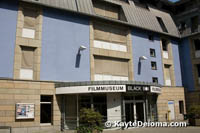 From early cave paintings, man has been fascinated with reproducing the physical world in two dimensions, and finding ways to represent the concepts of motion and the passage of time. The Film Museum in Dusseldorf takes you along on the fascinating journey of technological development from those earliest depictions of motion through the many precursors to photographic moving pictures up to the advent of moving film frames. The ground floor of the Film Museum is the Black Box Theater which shows historic and current art films. The museum exhibits begin up one level on the first floor. Although all the history is there, it’s not really laid out chronologically. Historical elements are introduced throughout.
From early cave paintings, man has been fascinated with reproducing the physical world in two dimensions, and finding ways to represent the concepts of motion and the passage of time. The Film Museum in Dusseldorf takes you along on the fascinating journey of technological development from those earliest depictions of motion through the many precursors to photographic moving pictures up to the advent of moving film frames. The ground floor of the Film Museum is the Black Box Theater which shows historic and current art films. The museum exhibits begin up one level on the first floor. Although all the history is there, it’s not really laid out chronologically. Historical elements are introduced throughout.
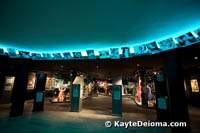 You enter through the Pantheon of Film History, a tribute to directors honoring the contributions of early Russian, Polish, Japanese, Italian, and of course, German filmmakers like Rainer Werner Fassbinder, Werner Herzog and Dusseldorf native son, Wim Wenders. Hollywood icons like Alfred Hitchcock and Charlie Chaplin are included as well. Photos circle a domed ceiling and interactive video columns allow you to watch short film excerpts.
You enter through the Pantheon of Film History, a tribute to directors honoring the contributions of early Russian, Polish, Japanese, Italian, and of course, German filmmakers like Rainer Werner Fassbinder, Werner Herzog and Dusseldorf native son, Wim Wenders. Hollywood icons like Alfred Hitchcock and Charlie Chaplin are included as well. Photos circle a domed ceiling and interactive video columns allow you to watch short film excerpts.
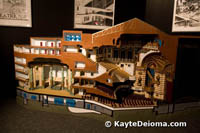 Beyond the Pantheon, the “Movie Cult – Movie Theater” room is devoted to the movie house experience. Movie posters featuring Marlene Dietrich, Greta Garbo and Ingred Bergman line the walls. There is a model of the 6200-seat Roxy Theatre in New York, the largest silent movie theater built in its day. A traveling cinema from around 1910 has been recreated and is used occasionally to show films for group tours.
Beyond the Pantheon, the “Movie Cult – Movie Theater” room is devoted to the movie house experience. Movie posters featuring Marlene Dietrich, Greta Garbo and Ingred Bergman line the walls. There is a model of the 6200-seat Roxy Theatre in New York, the largest silent movie theater built in its day. A traveling cinema from around 1910 has been recreated and is used occasionally to show films for group tours.
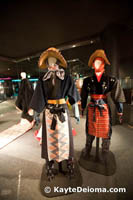 In the center of this area, period movie costumes from various international films, including Akira Kurasawa’s Dreams, are displayed in glass cases. There is also an exhibit of movie-related merchandise, from Charlie Chaplin and Laurel and Hardy memorabilia to Star Wars action figures and Disney character toys.
In the center of this area, period movie costumes from various international films, including Akira Kurasawa’s Dreams, are displayed in glass cases. There is also an exhibit of movie-related merchandise, from Charlie Chaplin and Laurel and Hardy memorabilia to Star Wars action figures and Disney character toys.
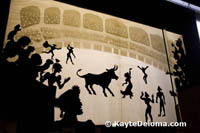 On the second floor, a collection of original shadow puppets from Turkey, China and Indonesia show how these early cut-outs were used to create the experience of watching a story take place on a screen. German filmmaker Lotte Reiniger combined silhouettes like these with film to create animated films in the 1920s and 30s. Silhouettes used in her films The Adventure of Prince Achmed, Harlekin, Carmen, and the unfinished work, Prosperina, are on display.
On the second floor, a collection of original shadow puppets from Turkey, China and Indonesia show how these early cut-outs were used to create the experience of watching a story take place on a screen. German filmmaker Lotte Reiniger combined silhouettes like these with film to create animated films in the 1920s and 30s. Silhouettes used in her films The Adventure of Prince Achmed, Harlekin, Carmen, and the unfinished work, Prosperina, are on display.
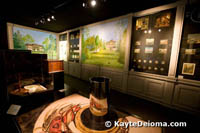 In the ” Palace of Illusions,” the press of a button changes the room lighting to show off the special effects created in 17th century “light paintings.” Back lighting allows different parts of the painting to glow, so that as day turns to night in the picture, the moon shines and lanterns and windows become lit.
In the ” Palace of Illusions,” the press of a button changes the room lighting to show off the special effects created in 17th century “light paintings.” Back lighting allows different parts of the painting to glow, so that as day turns to night in the picture, the moon shines and lanterns and windows become lit.
To get a little more interactive, you can step into the “Flash-Lock” room to make frozen shadows on the wall, or pay a visit to the walk-in Camera Oscura, which wasn’t project ting anything when I tried it.
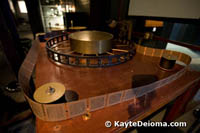 The second floor is also home to a display of the progression in development of film cameras and projecting equipment in “The Captured Outer World” and “The Projected Inner World”. The collection includes German, American, Russian and French cameras from the turn of the century through the 1980s. There is a functional replica of Le Théatre Optique, a precursor to film which projected a series of hand-painted frames on a transparent screen to simulate movement. It is sometimes demonstrated on group tours.
The second floor is also home to a display of the progression in development of film cameras and projecting equipment in “The Captured Outer World” and “The Projected Inner World”. The collection includes German, American, Russian and French cameras from the turn of the century through the 1980s. There is a functional replica of Le Théatre Optique, a precursor to film which projected a series of hand-painted frames on a transparent screen to simulate movement. It is sometimes demonstrated on group tours.
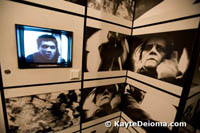 Another series exhibits demonstrates how camera angle and editing can replicate or reinvent reality. Video clips from Polish filmmaker Wsewolod Pudowkin’s short film The Mother, and Jonathan Demme’s Silence of the Lamb are shown on small screens surrounded by individual frames from the films to illustrate choices that are made in editing.
Another series exhibits demonstrates how camera angle and editing can replicate or reinvent reality. Video clips from Polish filmmaker Wsewolod Pudowkin’s short film The Mother, and Jonathan Demme’s Silence of the Lamb are shown on small screens surrounded by individual frames from the films to illustrate choices that are made in editing.
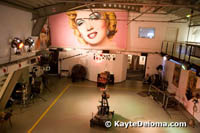 The third level takes you into the world of silent films in one room and sound effects in the next. Then pass through a film studio, where cameras, lights and a wind machine are all set to go, and a painted cardboard cutout of the back of a man in jeans and a leather jacket stands at a bar. Museum patrons used to be able to use the camera on the dolly in the middle of the room, but it has been vandalized and doesn’t work any more.
The third level takes you into the world of silent films in one room and sound effects in the next. Then pass through a film studio, where cameras, lights and a wind machine are all set to go, and a painted cardboard cutout of the back of a man in jeans and a leather jacket stands at a bar. Museum patrons used to be able to use the camera on the dolly in the middle of the room, but it has been vandalized and doesn’t work any more.
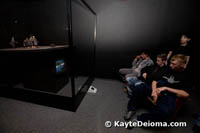 Also on level three you’ll find an introduction to animation, from graphics to “stop action”. The 1988 Academy Award winning short animation, Balance, by German bothers Christoph and Wolfgang Lauenstein, plays on a small screen underneath a platform where the original stop-action figures from the film are mounted.
Also on level three you’ll find an introduction to animation, from graphics to “stop action”. The 1988 Academy Award winning short animation, Balance, by German bothers Christoph and Wolfgang Lauenstein, plays on a small screen underneath a platform where the original stop-action figures from the film are mounted.
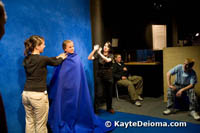 The Blue Screen exhibit lets you try out some special effects for yourself, standing in front of the blue screen and seeing yourself on television against a different background. A blue wrap lets you become a floating head or headless body, or whatever else you can dream up.
The Blue Screen exhibit lets you try out some special effects for yourself, standing in front of the blue screen and seeing yourself on television against a different background. A blue wrap lets you become a floating head or headless body, or whatever else you can dream up.
When you walk through a round alcove draped in red, be sure you open the curtains, although there’s no sign in English telling you to do so. Behind the red drapes are original drawings and paintings by directors such as Federico Fellini, Werner Herzog and Akira Kurasawa. Some are sketches from films, others are unrelated artwork.
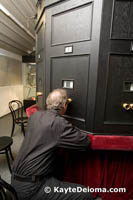 On the fourth and final floor, a Kaiserpanorama takes center stage. Invented in 1880, this ten-sided black tower surrounded by chairs has stereo viewers at each position where visitors can sit and look at black and white travel photos in 3D. Every few second, the photos inside the box rotate so you get a new view. Kaiserpanoramas were popular in Germany until the 1930s. Other technologies for three dimensional viewing from painted glassine panel sets to View Master slide-wheel viewers to holographic projections complete the exhibit.
On the fourth and final floor, a Kaiserpanorama takes center stage. Invented in 1880, this ten-sided black tower surrounded by chairs has stereo viewers at each position where visitors can sit and look at black and white travel photos in 3D. Every few second, the photos inside the box rotate so you get a new view. Kaiserpanoramas were popular in Germany until the 1930s. Other technologies for three dimensional viewing from painted glassine panel sets to View Master slide-wheel viewers to holographic projections complete the exhibit.
Most of the displays in the Film Museum are captioned in both German and English. There is an elevator for those can’t handle all the stairs. Check the Film Museum website for current open hours and admission.
Dusseldorf Film Museum
Schulstrasse 4
40213 Dusseldorf
49 (0) 211-899-2232
www.duesseldorf.de/kultur/filmmuseum
email: filmmuseum@stadt.duesseldorf.de
Subway/U-Bahn Station: Heinrich-Heine-Allee
Streetcar Stop: Heinrich-Heine-Allee or Benrather Strasse
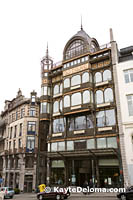 A true gem on the Mont des Arts in Brussels is the Musical Instrument Museum (MIM), home to one of the largest collections of musical apparatuses in the world. Founded in 1877 as part of the Royal Museums of Art and History, the museum moved into the former Old England department store, an 1899 masterpiece of Art Nouveau architecture, in 2000. Twelve hundred of the 7,000 instruments in the collection are on display at any given time.
A true gem on the Mont des Arts in Brussels is the Musical Instrument Museum (MIM), home to one of the largest collections of musical apparatuses in the world. Founded in 1877 as part of the Royal Museums of Art and History, the museum moved into the former Old England department store, an 1899 masterpiece of Art Nouveau architecture, in 2000. Twelve hundred of the 7,000 instruments in the collection are on display at any given time.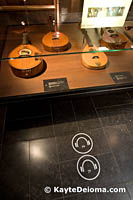 there was a printed English language guide to help you navigate the museum, but they were all out of them. You can still enjoy the museum without understanding the descriptions since included in the price of admission is an infrared audio tour that plays the music of over 200 of the instruments when you stand near the designated headphone icon.
there was a printed English language guide to help you navigate the museum, but they were all out of them. You can still enjoy the museum without understanding the descriptions since included in the price of admission is an infrared audio tour that plays the music of over 200 of the instruments when you stand near the designated headphone icon.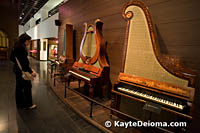 Listening to the rare and exotic instruments while admiring their artistry and craftsmanship becomes a more sensory experience when there’s no intellectual information to clutter the mind. You can experience the drone of Tibetan trumpets and the sinewy tones of serpent-headed Russian clarinets. In the keyboard section you can hear the difference between the harpsichords, spinets, virginals, clavicytheriums, clavichords and fortepianos.
Listening to the rare and exotic instruments while admiring their artistry and craftsmanship becomes a more sensory experience when there’s no intellectual information to clutter the mind. You can experience the drone of Tibetan trumpets and the sinewy tones of serpent-headed Russian clarinets. In the keyboard section you can hear the difference between the harpsichords, spinets, virginals, clavicytheriums, clavichords and fortepianos.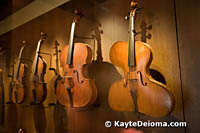 Strings are also well represented with the work of some the best known luthiers, as well as many one-of-a-kind creations. Examples of stringed instruments from five continents can be compared from ancient times to the present.
Strings are also well represented with the work of some the best known luthiers, as well as many one-of-a-kind creations. Examples of stringed instruments from five continents can be compared from ancient times to the present.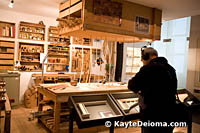 Restoration workshops for keyboards and stringed instruments are integrated into the exhibit galleries and show the tools and processes of instrument construction and repair.
Restoration workshops for keyboards and stringed instruments are integrated into the exhibit galleries and show the tools and processes of instrument construction and repair.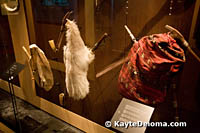 You can see a wide selection of brass horns developed by Belgian musician and inventor Adolph Sax, best known for designing the instrument that was to become known as the saxophone. In another direction, you’ll find the evolution of the bagpipe through different cultures around the world.
You can see a wide selection of brass horns developed by Belgian musician and inventor Adolph Sax, best known for designing the instrument that was to become known as the saxophone. In another direction, you’ll find the evolution of the bagpipe through different cultures around the world.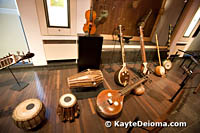 MIM offers a series of concerts in their auditorium. On the first Wednesday afternoon of the month, the museum is free to the public and also presents a selection of live musical presentations in the exhibit galleries. They also offer family concerts on the free Wednesdays.
MIM offers a series of concerts in their auditorium. On the first Wednesday afternoon of the month, the museum is free to the public and also presents a selection of live musical presentations in the exhibit galleries. They also offer family concerts on the free Wednesdays.
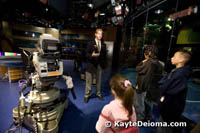
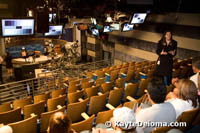 The studios available to tour vary depending on what shows are in production and what time of day it is. Early in the day, you might get to visit Studio 6A, the set of Late Night with Conan O’Brian (now Seth Meyers), and sit where the live studio audience sits during taping. Later in the day, if Seth is taping, you might see the Today Show or Dateline NBC set. On the 10:15 am tour, we got to sit in Conan’s (now Seth’s) audience seats and visit Studio 8G, where NBC Nightly News and NBC Sports are taped.
The studios available to tour vary depending on what shows are in production and what time of day it is. Early in the day, you might get to visit Studio 6A, the set of Late Night with Conan O’Brian (now Seth Meyers), and sit where the live studio audience sits during taping. Later in the day, if Seth is taping, you might see the Today Show or Dateline NBC set. On the 10:15 am tour, we got to sit in Conan’s (now Seth’s) audience seats and visit Studio 8G, where NBC Nightly News and NBC Sports are taped.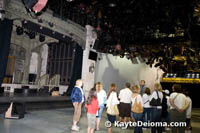 As someone who came of age with Saturday Night Live, the highlight was standing on the set of Studio 8H where comedians from John Belushi, Chevy Chase, Gilda Radner and Steve Martin to Eddie Murphy, Janeane Garafalo, Adam Sandler and Chris Rock went from unknowns to household names during their time on SNL. A myriad of Fresnels and other light panels are suspended above. Blue and yellow clap seats circle the back of the studio. Since the show was in hiatus, we got to stand in front of the actual dual Grand Central Terminal sets that have been the primary backdrop of the show since 2003.
As someone who came of age with Saturday Night Live, the highlight was standing on the set of Studio 8H where comedians from John Belushi, Chevy Chase, Gilda Radner and Steve Martin to Eddie Murphy, Janeane Garafalo, Adam Sandler and Chris Rock went from unknowns to household names during their time on SNL. A myriad of Fresnels and other light panels are suspended above. Blue and yellow clap seats circle the back of the studio. Since the show was in hiatus, we got to stand in front of the actual dual Grand Central Terminal sets that have been the primary backdrop of the show since 2003.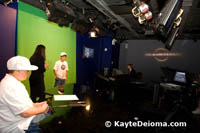 Between studios, you traverse halls lined with photos of well-known and lesser-known faces of NBC. After a quick stop in the Green Room to see where make-up magic is done, the final stop is a studio used just for tours. Each guest or group is photographed at a news desk with the New York skyline in the background. Two lucky volunteers also have the opportunity to be on the closed circuit TV. One gets to sit at the News Desk and read the news from a teleprompter. The other will report the weather from in front of a Green Screen, trying to keep track of which way to point his or her arm so it appears in the right place on the map.
Between studios, you traverse halls lined with photos of well-known and lesser-known faces of NBC. After a quick stop in the Green Room to see where make-up magic is done, the final stop is a studio used just for tours. Each guest or group is photographed at a news desk with the New York skyline in the background. Two lucky volunteers also have the opportunity to be on the closed circuit TV. One gets to sit at the News Desk and read the news from a teleprompter. The other will report the weather from in front of a Green Screen, trying to keep track of which way to point his or her arm so it appears in the right place on the map.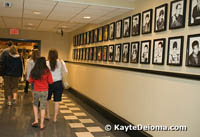
 From early cave paintings, man has been fascinated with reproducing the physical world in two dimensions, and finding ways to represent the concepts of motion and the passage of time. The Film Museum in Dusseldorf takes you along on the fascinating journey of technological development from those earliest depictions of motion through the many precursors to photographic moving pictures up to the advent of moving film frames. The ground floor of the Film Museum is the Black Box Theater which shows historic and current art films. The museum exhibits begin up one level on the first floor. Although all the history is there, it’s not really laid out chronologically. Historical elements are introduced throughout.
From early cave paintings, man has been fascinated with reproducing the physical world in two dimensions, and finding ways to represent the concepts of motion and the passage of time. The Film Museum in Dusseldorf takes you along on the fascinating journey of technological development from those earliest depictions of motion through the many precursors to photographic moving pictures up to the advent of moving film frames. The ground floor of the Film Museum is the Black Box Theater which shows historic and current art films. The museum exhibits begin up one level on the first floor. Although all the history is there, it’s not really laid out chronologically. Historical elements are introduced throughout. You enter through the Pantheon of Film History, a tribute to directors honoring the contributions of early Russian, Polish, Japanese, Italian, and of course, German filmmakers like Rainer Werner Fassbinder, Werner Herzog and Dusseldorf native son, Wim Wenders. Hollywood icons like Alfred Hitchcock and Charlie Chaplin are included as well. Photos circle a domed ceiling and interactive video columns allow you to watch short film excerpts.
You enter through the Pantheon of Film History, a tribute to directors honoring the contributions of early Russian, Polish, Japanese, Italian, and of course, German filmmakers like Rainer Werner Fassbinder, Werner Herzog and Dusseldorf native son, Wim Wenders. Hollywood icons like Alfred Hitchcock and Charlie Chaplin are included as well. Photos circle a domed ceiling and interactive video columns allow you to watch short film excerpts. Beyond the Pantheon, the “Movie Cult – Movie Theater” room is devoted to the movie house experience. Movie posters featuring Marlene Dietrich, Greta Garbo and Ingred Bergman line the walls. There is a model of the 6200-seat Roxy Theatre in New York, the largest silent movie theater built in its day. A traveling cinema from around 1910 has been recreated and is used occasionally to show films for group tours.
Beyond the Pantheon, the “Movie Cult – Movie Theater” room is devoted to the movie house experience. Movie posters featuring Marlene Dietrich, Greta Garbo and Ingred Bergman line the walls. There is a model of the 6200-seat Roxy Theatre in New York, the largest silent movie theater built in its day. A traveling cinema from around 1910 has been recreated and is used occasionally to show films for group tours. In the center of this area, period movie costumes from various international films, including Akira Kurasawa’s Dreams, are displayed in glass cases. There is also an exhibit of movie-related merchandise, from Charlie Chaplin and Laurel and Hardy memorabilia to Star Wars action figures and Disney character toys.
In the center of this area, period movie costumes from various international films, including Akira Kurasawa’s Dreams, are displayed in glass cases. There is also an exhibit of movie-related merchandise, from Charlie Chaplin and Laurel and Hardy memorabilia to Star Wars action figures and Disney character toys. On the second floor, a collection of original shadow puppets from Turkey, China and Indonesia show how these early cut-outs were used to create the experience of watching a story take place on a screen. German filmmaker Lotte Reiniger combined silhouettes like these with film to create animated films in the 1920s and 30s. Silhouettes used in her films The Adventure of Prince Achmed, Harlekin, Carmen, and the unfinished work, Prosperina, are on display.
On the second floor, a collection of original shadow puppets from Turkey, China and Indonesia show how these early cut-outs were used to create the experience of watching a story take place on a screen. German filmmaker Lotte Reiniger combined silhouettes like these with film to create animated films in the 1920s and 30s. Silhouettes used in her films The Adventure of Prince Achmed, Harlekin, Carmen, and the unfinished work, Prosperina, are on display. In the ” Palace of Illusions,” the press of a button changes the room lighting to show off the special effects created in 17th century “light paintings.” Back lighting allows different parts of the painting to glow, so that as day turns to night in the picture, the moon shines and lanterns and windows become lit.
In the ” Palace of Illusions,” the press of a button changes the room lighting to show off the special effects created in 17th century “light paintings.” Back lighting allows different parts of the painting to glow, so that as day turns to night in the picture, the moon shines and lanterns and windows become lit. The second floor is also home to a display of the progression in development of film cameras and projecting equipment in “The Captured Outer World” and “The Projected Inner World”. The collection includes German, American, Russian and French cameras from the turn of the century through the 1980s. There is a functional replica of Le Théatre Optique, a precursor to film which projected a series of hand-painted frames on a transparent screen to simulate movement. It is sometimes demonstrated on group tours.
The second floor is also home to a display of the progression in development of film cameras and projecting equipment in “The Captured Outer World” and “The Projected Inner World”. The collection includes German, American, Russian and French cameras from the turn of the century through the 1980s. There is a functional replica of Le Théatre Optique, a precursor to film which projected a series of hand-painted frames on a transparent screen to simulate movement. It is sometimes demonstrated on group tours. Another series exhibits demonstrates how camera angle and editing can replicate or reinvent reality. Video clips from Polish filmmaker Wsewolod Pudowkin’s short film The Mother, and Jonathan Demme’s Silence of the Lamb are shown on small screens surrounded by individual frames from the films to illustrate choices that are made in editing.
Another series exhibits demonstrates how camera angle and editing can replicate or reinvent reality. Video clips from Polish filmmaker Wsewolod Pudowkin’s short film The Mother, and Jonathan Demme’s Silence of the Lamb are shown on small screens surrounded by individual frames from the films to illustrate choices that are made in editing. The third level takes you into the world of silent films in one room and sound effects in the next. Then pass through a film studio, where cameras, lights and a wind machine are all set to go, and a painted cardboard cutout of the back of a man in jeans and a leather jacket stands at a bar. Museum patrons used to be able to use the camera on the dolly in the middle of the room, but it has been vandalized and doesn’t work any more.
The third level takes you into the world of silent films in one room and sound effects in the next. Then pass through a film studio, where cameras, lights and a wind machine are all set to go, and a painted cardboard cutout of the back of a man in jeans and a leather jacket stands at a bar. Museum patrons used to be able to use the camera on the dolly in the middle of the room, but it has been vandalized and doesn’t work any more. Also on level three you’ll find an introduction to animation, from graphics to “stop action”. The 1988 Academy Award winning short animation, Balance, by German bothers Christoph and Wolfgang Lauenstein, plays on a small screen underneath a platform where the original stop-action figures from the film are mounted.
Also on level three you’ll find an introduction to animation, from graphics to “stop action”. The 1988 Academy Award winning short animation, Balance, by German bothers Christoph and Wolfgang Lauenstein, plays on a small screen underneath a platform where the original stop-action figures from the film are mounted. The Blue Screen exhibit lets you try out some special effects for yourself, standing in front of the blue screen and seeing yourself on television against a different background. A blue wrap lets you become a floating head or headless body, or whatever else you can dream up.
The Blue Screen exhibit lets you try out some special effects for yourself, standing in front of the blue screen and seeing yourself on television against a different background. A blue wrap lets you become a floating head or headless body, or whatever else you can dream up. On the fourth and final floor, a Kaiserpanorama takes center stage. Invented in 1880, this ten-sided black tower surrounded by chairs has stereo viewers at each position where visitors can sit and look at black and white travel photos in 3D. Every few second, the photos inside the box rotate so you get a new view. Kaiserpanoramas were popular in Germany until the 1930s. Other technologies for three dimensional viewing from painted glassine panel sets to View Master slide-wheel viewers to holographic projections complete the exhibit.
On the fourth and final floor, a Kaiserpanorama takes center stage. Invented in 1880, this ten-sided black tower surrounded by chairs has stereo viewers at each position where visitors can sit and look at black and white travel photos in 3D. Every few second, the photos inside the box rotate so you get a new view. Kaiserpanoramas were popular in Germany until the 1930s. Other technologies for three dimensional viewing from painted glassine panel sets to View Master slide-wheel viewers to holographic projections complete the exhibit.